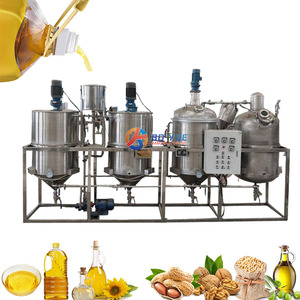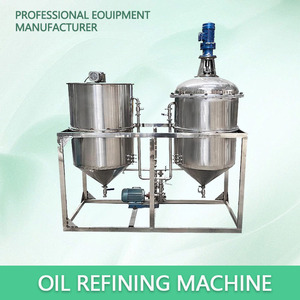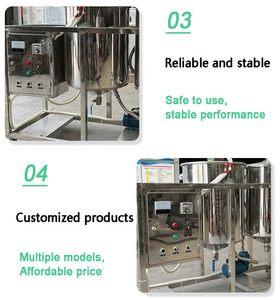(2025 products available)













































































































































































A palm oil separator is a machine that distinguishes palm oil from impurities, dirt, or water. Palm oil separators are broadly classified into batch or manual separators and continuous separators.
Within these classes, there are different types of palm oil separators based on design and function, such as disc stack palm oil separators, horizontal screw press separators, and clarifiers.
Production Capacity
The production capacity of palm oil separators is one critical specification. The production capacity defines the volume of palm oil that the separator can process within a specific timeframe. This is usually expressed in tonnes per hour (TPH) or litres per minute (LPM). For example, some palm oil separators of 1 to 5 tonnes per hour are commonly used in small-scale palm oil processing factories. Some separators can process up to 20 to 30 tonnes per hour or even more. Higher capacities are usually found in large industrial palm oil separating plants.
Separation Efficiency
Separation efficiency is another critical specification of palm oil separators. It determines the percentage of crude palm oil that the separator extracts from the palm oil emulsion. High separation efficiency means more palm oil extracted and less residual palm oil left in the separator. Some palm oil separators can achieve separation efficiencies of over 95%.
Operating Method
Depending on the type of separator: centrifugal, sedimentation, or decanter separator, the operator will use a different method to operate the separator. This includes how to prepare the separator for operation, how to feed the separator, how to adjust and control the separator, and how to clean and maintain it after use.
It is very important to maintain the palm oil separator properly. This can help it work better and last longer. Cleaning the separator regularly is very important. This stops blockages and keeps the oil separated well. The right type of cleansing liquid should be used to avoid damaging the separator or its parts. People who maintain the separator should be properly trained so they know how to do it safely and right. Also, following the manufacturer’s instructions or advice about the separator’s care can be very helpful. It is important to always use the recommended parts for repairs or replacements.
A palm oil separator machine is indispensable in the palm oil milling process. It plays a pivotal role in various scenarios, especially within palm oil processing factories and mills.
After the crude palm oil has been filtered of any solid contaminants like palm nuts and fiber, it then goes through the next vital step wherein the palm oil separator steps in separating the crude palm oil from the palm oil sterin. Both these fractions, crude palm oil is bright yellow or orange-colored oil, whereas the palm oil sterin is a whitish or light pink solid fat. The separation process can either be done using the traditional method through cooling or using modern centrifugal separating machines.
Centrifugal separators are common and essential pieces of equipment found in palm oil processing factories and mills. They separate palm oil from palm oil sterin efficiently, quickly and smoothly, an improvement over traditional methods that takes longer and may be less effective. Using a palm oil centrifuge separator can increase the mill's overall productivity because it can separate oil constantly and at higher volumes.
Many manufacturers and suppliers of palm oil separators offer machines of different sizes and capacities. They are usually high-capacity oil separators that can process large volumes. They are also very strong and sturdy and may be made from stainless steel. This will ensure that the palm oil separator can handle heavy, constant tasks with ease, also maintaining its excellent condition over many years. It may also be explosion-proof and have other safety features that keep users safe at all times while ensuring that the palm oil is separated efficiently.
Some mills and factories may have smaller palm oil separators. These may be used at crude oil production sites in rural areas or small family-owned businesses where palm oil is processed on a smaller scale, more manually, on farm.
Here are some important factors to consider when choosing palm oil separators for sale:
Separator capacity
The capacity of palm oil separators is often stated in terms of the maximum volume of crude palm oil they can process per hour. Purchasers need to match the separator's capacity with the expected volume of crude palm oil production.
Separator technology and efficiency
Various types of palm oil separators are available, such as centrifugal separators, decanter separators, and others. Each of these separator types has its own advantages and efficiency. Buyers need to select the right separator based on their technical requirements and separating efficiency. It is also important to consider the energy consumption of the separator.
Operating flexibility
Some palm oil separators can process different types of crude palm oils, while others are only suitable for specific ones. Moreover, the separator may be able to adjust the separating temperature and pressure to adapt to different qualities of crude palm oil.
Maintenance and service
When choosing palm oil separators, buyers also need to consider the maintenance needs of the equipment and available technical support services. Convenient maintenance and timely technical support can ensure the long-term stable operation of the equipment.
Safety features
Purchasers need to ensure that the separator has appropriate safety features, such as emergency stop systems, protective covers, etc., to reduce operational risks.
Q1: What type of palm oil separator does a 5-tonne/day crude palm oil mill recommend?
A1: A vertical palm oil separator is preferable for a mill of that size.
Q2: Does a palm oil separator have a fractal mechanism?
A2: No, a palm oil separator works on the centrifugal separation principle.
Q3: What is the difference between interfacial and sedimentation separation in a palm oil separator?
A3: The former refers to separating substances at interfaces, while sedimentation separation refers to separating suspended particles that settle at the bottom.
Q4: What separate powders in a sedimentation palm oil separator?
A4: Gravitational forces separating particles. Inertia, size, and density of the particles also matter.